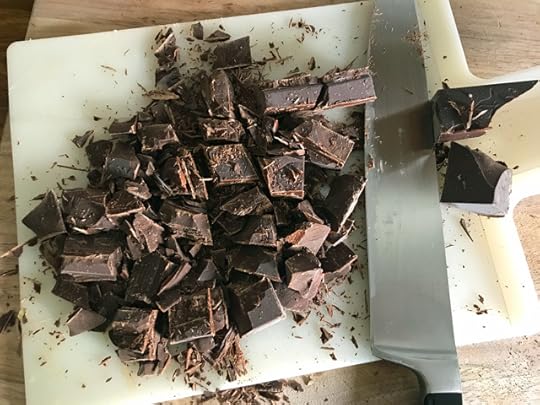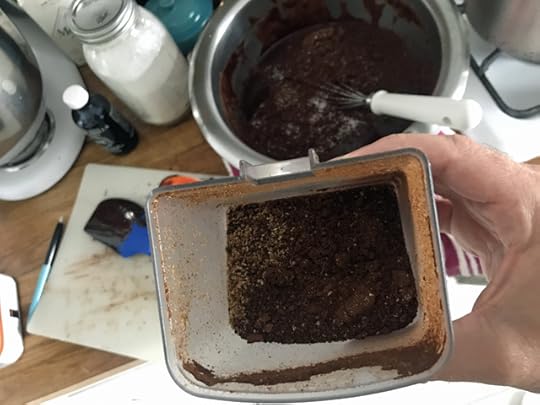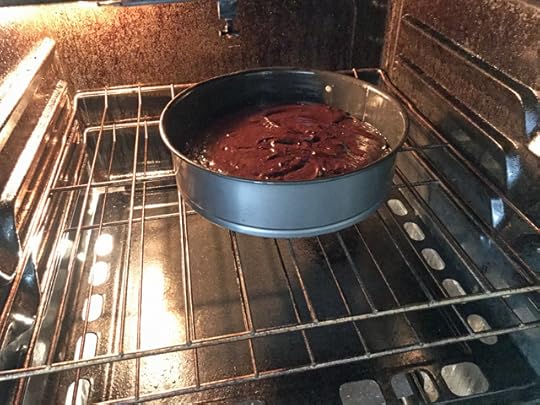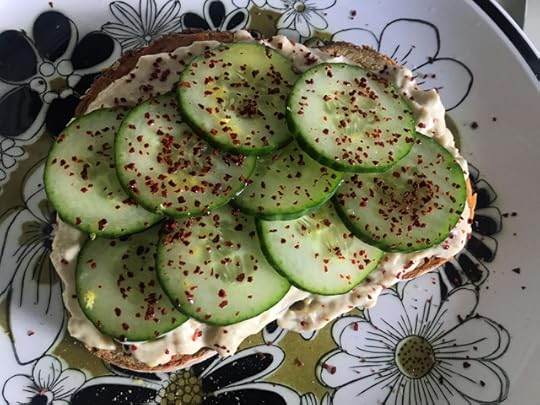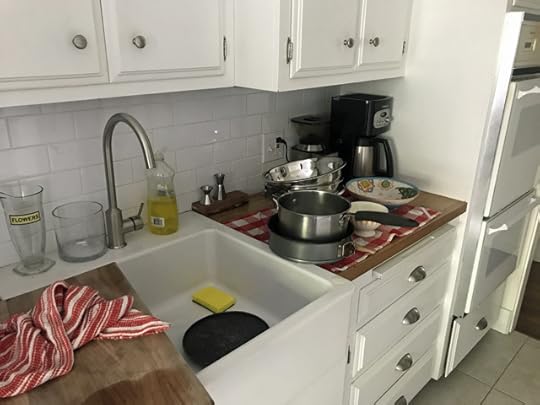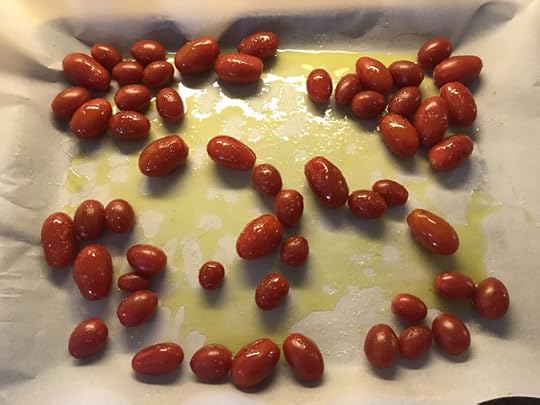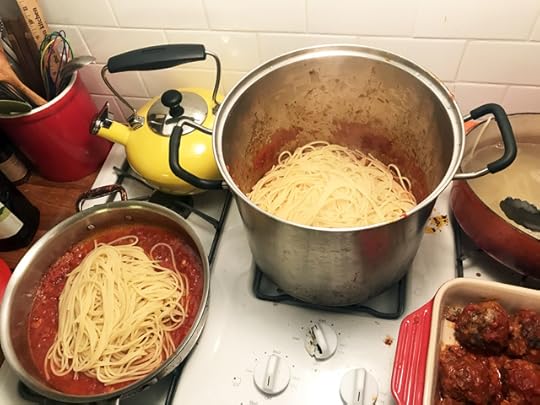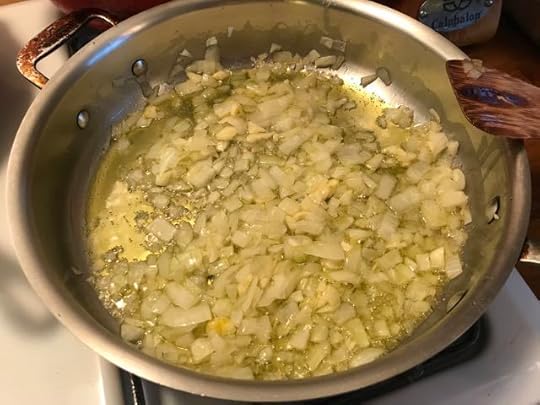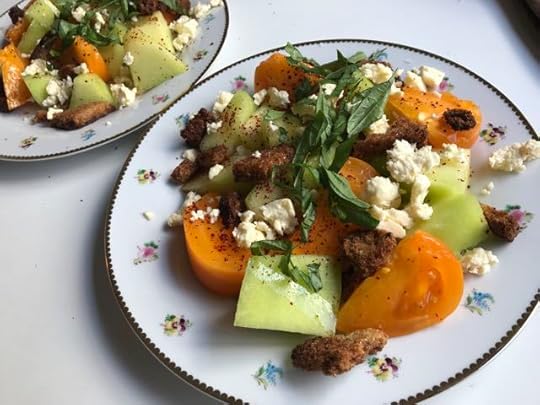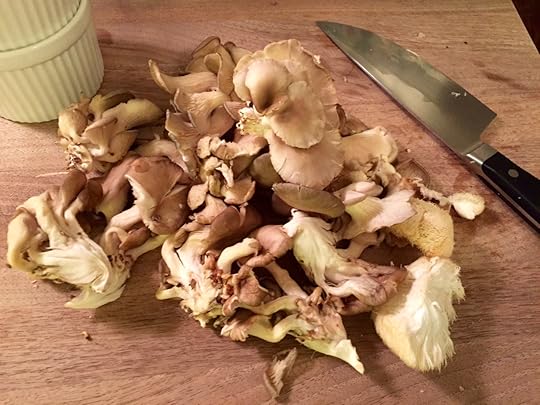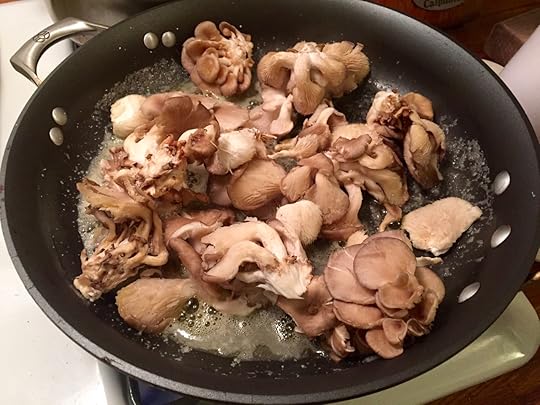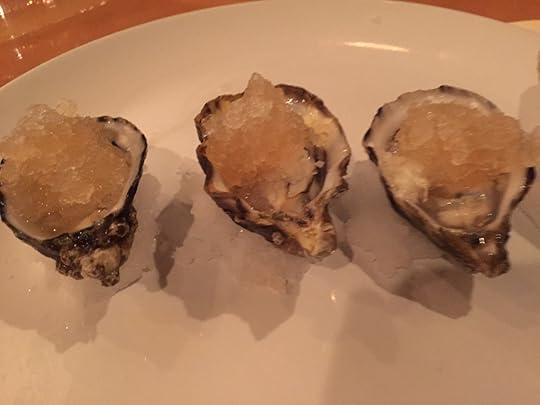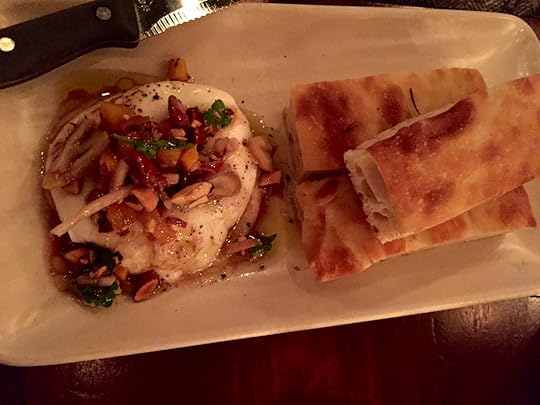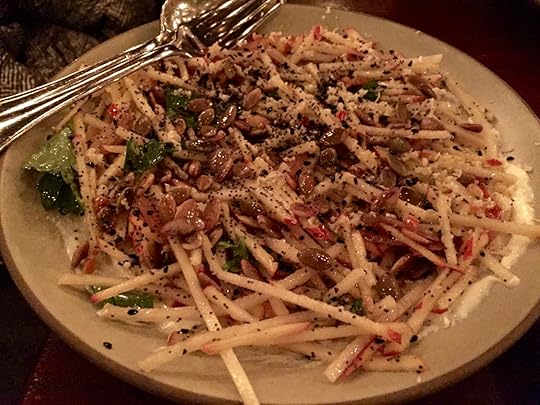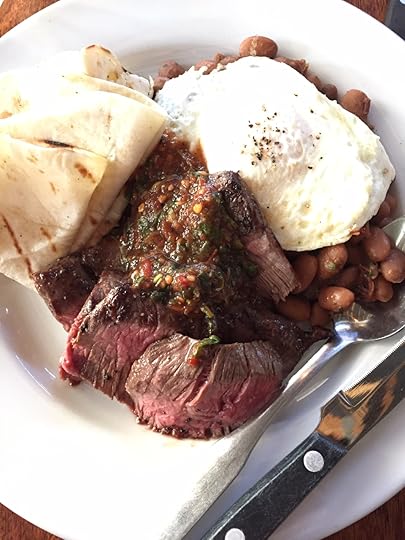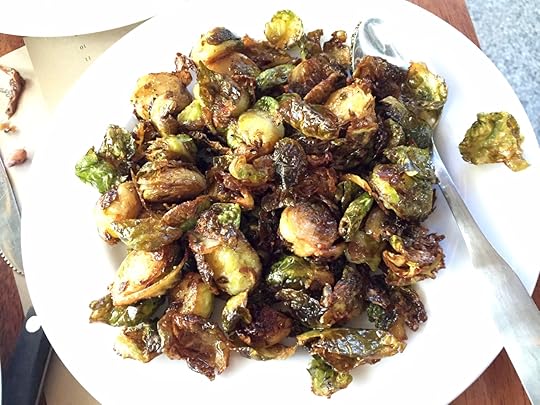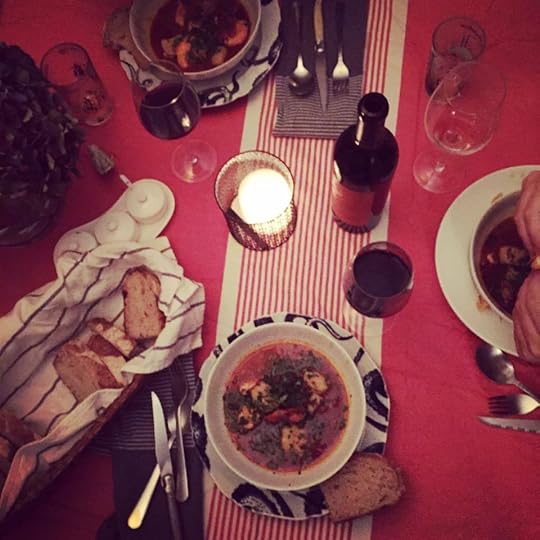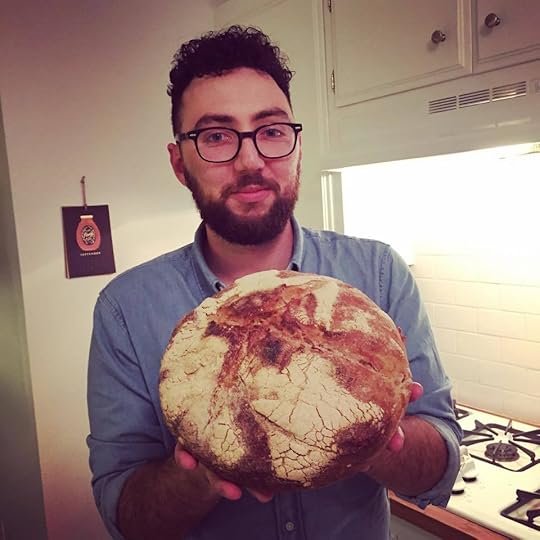Adam D. Roberts's Blog, page 17
September 18, 2017
Anatomy of a Dinner Party (A Timeline of Caesar Salad, Spaghetti and Meatballs, and Flourless Chocolate Cake All Cooked And Served in A Single Day)
My friend Ryan O’Connell is one of my favorite people. If you don’t know who he is, hop on to Amazon now and check out his book, I’m Special, and come back here once you’ve bought it and read it. Not only did he write that book, but now he’s writing for fall’s most anticipated TV show: the reboot of Will & Grace. So Ryan’s a talented guy who has great taste in wine and even better taste in dinner parties: he loves my cooking. For his birthday, I told him I’d make him a dinner and he could choose the menu. He thought on it and came back with “spaghetti and meatballs, because I know you’ll do it really, really well.” His boyfriend Jonathan loves my Caesar salad, so we added that to the menu. Later I e-mailed to query about his favorite desserts and he wrote back: “My fave desserts are chocolate cake, chocolate pudding, and strawberry shortcake.” I combined a little from Column A and a little from Column B and chose my favorite dinner party staple, this flourless chocolate cake.
Everyone (Ryan, Jonathan, and our mutual friends Lara, Graydon, and Kyle) were all set to come over on Saturday night at 7:30 PM. So on Saturday morning, I set out for Gelson’s to get started on my food shopping when I had an idea: what if I documented the whole thing, from the food shopping in the morning to the moment everyone leaves at the end of the night? Sort of a timeline of how I pull off a dinner party? Wouldn’t that be an epic, potentially useful post for people who want to pull off similar dinner parties? Well, either way, I did it, so without further ado, I present: a timeline of how I pulled off Ryan’s Birthday Dinner.
8:46 AM I wake up (was at another birthday in Pasadena the night before, too many of my friends have birthdays, so was feeling a little groggy) and finalize my shopping list, consulting the various recipes I plan to make that day. I do my shopping list in the notes app. Here it is in all its glory:
(I realize the timestamp doesn’t match the time I said I made the list, but I didn’t think to take a screenshot until later.)
(Also: the first three items aren’t dinner-party related: they were for my cat and my oatmeal respectively. Everything else, though, was for the dinner.)
(Also: I bought the orange but never used it. It was in case I decided to make Negronis, but we ended up having lots and lots of wine.)
9:36 AM Stumble out of my apartment, get in my car, and drive to Proof bakery for an iced coffee (cold brew, so extra battery-charging) and a financier, which is like the top of a muffin.
10:14 AM Arrive at Gelson’s and begin the shop. I start with produce, generally grabbing everything that I remember I need to grab without consulting the list… usually I get most of what I need off the top of my head, and then I check to see if I missed anything. Then I go aisle by aisle until I’m standing in the Jello aisle and taking a picture of my cart.
11 AM Back home, I carry three heavy bags of groceries in (I had to park around the block because Craig’s in New York and he left his car in our one parking spot), unpack them, and then put a tablespoon of butter in the springform pan to come to room temperature so I can butter the pan with it later.
11:25 AM Put a Joni Mitchell album on and hang out, reading a book (by which I mean, scrolling through Instagram stories) until it’s time to make the cake.
12 PM Make the cake! This is such an easy cake to make. (Again, here’s the recipe.) You basically just chop chocolate, put it in a bowl with butter, put the bowl on top of a pot of simmering water until everything melts, then stir in sugar, eggs, and, finally cocoa powder. I used the good stuff, some Valrhona I bought in Echo Park.
I also added a little ground coffee I had lying around because Ina Garten says that’s a good idea, and you should always trust Ina.
Oh, also: I added a teaspoon of salt (the recipe doesn’t call for it, but salt always makes dessert better) and a teaspoon of vanilla (same).
12:45 PM Cake goes into the oven.
12:46 PM While the cake’s baking, I make lunch for myself. I had some chickpeas and some fancy Soom Tahini I also bought at Cookbook in Echo Park, so I mashed those up together with lots of lemon juice, salt, and olive oil. I toasted rye bread, put the chickpea mash on top, and added a sliced cucumber with more lemon juice, olive oil, salt, and Aleppo pepper. A good light lunch for a big cooking day!
1 PM Read on the couch again, listening to more music (Craig bought this album I made fun of him for buying, Saint Etienne, because it seemed too cool for school, but it’s actually pretty great).
1:45 PM Cake comes out of the oven.
Here’s how I like to test if it’s done: I use a piece of spaghetti.
If it comes out clean, you’re good. This cake’s tricky because the center stays pretty wet while the outsides dry up much faster. So I take it out after about an hour when the spaghetti comes out 90% clean.
2 PM Clean up the cake and lunch mess. This is probably the most important thing I can teach you about hosting a dinner party: clean EVERYTHING as you go along, or you will have a disaster of epic proportions by the time the real cooking rolls around.
3:30 PM Shower. (Ended up doing a deep cleaning of my kitchen, but that’s not something you need to do at EVERY dinner party. It just needed to be done.)
4:30 PM Make the Caesar dressing. This is one of my most popular things I make, and my strategy is just to use a lot of garlic (about 5 cloves), a lot of anchovies (about 6 packed in oil), a lot of mustard (a tablespoon), an egg yolk…
Then lots of lemon juice (from two lemons) squeezed through a strainer straight into the blender:
Then a big pinch of salt, some pepper, the lid goes on, the blender goes on, and I slowly pour in about 3/4ths a cup of olive oil, until thick:
That’s a pretty killer dressing, though I made a mistake this time around: usually I grind a bunch of Parmesan in the blender before making the dressing so the remnant Parm helps it thicken sooner (this took a lot more oil). Plus, grinding Parmesan in the blender is one of my favorite things to do when hosting a dinner party (another Ina trick) because you end up using a lot more when it’s that easy to prepare and it makes everything taste so good.
So I cleaned the blender, after making the dressing, and then cut three wedges of really good Parmesan (it makes a big difference, God I’m so Ina-influenced) into cubes and, in little groups, popped them into the blender to be pulverized.
[Note: see the picture above? When buying Parmesan, make sure to buy the wedges that only have the rind at the top. Sometimes you’ll get screwed if the rind goes around in an L-shape, you get less usable Parmesan that way. I hope that made sense.]
5:06 PM Start sauce. So the meatball recipe I used (a pretty irrefutable one from Serious Eats) said you can make any kind of tomato sauce. So I got out my stockpot and made a sauce with lots of olive oil, lots of chopped onion, lots of garlic, tomato paste, and chile flakes that I cooked a bit together to infuse the oil and to get a little toasty:
Then I added three cans of San Marzano tomatoes (crushed by hand) and a big pinch of salt:
Brought that to a boil and then, once again, CLEANED THE KITCHEN. I’m telling you, it’s the most important thing.
Also, at this point, I refrigerated the plates for the salad. A nice, easy touch that makes a subtle but noticeable difference.
5:44 PM Roast cherry tomatoes for the Caesar salad. This is an easy trick (OK, another Ina trick) where you roast cherry tomatoes on a cookie sheet in a hot oven with olive oil, salt, and pepper until they burst and get a little charred:
5:47 PM While those were roasting, I set the table. This is probably my favorite pre-dinner party moment, when the excitement starts to kick in… ooh, people are coming over soon and I haven’t even started making the meatballs yet!
6 PM Start making the meatballs. This recipe is pretty epic (again, here’s the link); I skipped the whole thing where you gelatinize chicken stock and chop that for your meatballs. But I did buy good bread, cut the crusts off, cut the insides into cubes, soak the cubes in whole milk, etc, etc.
I actually had too much bread so when the tomatoes came out of the oven, I decided to use the extra cubes to make croutons. It was this easy: tossed the cubes with olive oil, salt, and pepper and popped into the 400 degree oven until they were golden all over.
6:28 PM At this point, the sauce was done, and I set two ladlefuls of it aside for our vegetarian friend Jonathan who wouldn’t want sauce that co-habitated with balls of meat. Doesn’t the sauce look good?
OK, now the meatball-making began in earnest, with only an hour to go before guests arrived. I cut it a little close.
The recipe’s really cool in that you use a stand mixer to whip together the milk-soaked bread, onion, garlic, oregano, parsley, ground fennel seed, egg yolks, and minced pancetta.
To that mixture, you add 1/3rd of your meat (I used a mixture of pork and ground beef from McCall’s) so that it really gets worked in, then you add the rest with your hands to keep the meatballs light.
7 PM Make a test meatball. This was a trick Sara Moulton taught me when I wrote my cookbook and I never forgot it: when making a meat mixture that you can’t taste raw, fry up a little bit so you can taste for seasoning. So that’s exactly what I did in a little pan with some olive oil:
Man, did that taste good. Like perfect. So we were ready to roll.
7:07 PM Roll the meatballs! I really cut this close. But this was fast work:
Under the broiler they went (that’s the other ingenious part of the recipe, so they don’t fall apart in a frying pan):
7:16 PM Light candles, fill water glasses. We’re down to the wire…
7:21 PM Meatballs out of the broiler and into the sauce.
They only need ten minutes to cook at a simmer, so I lowered the heat to like the ULTIMATE low and kept them in there for the first hour of the party and it was totally fine.
And, wouldn’t you know it, it’s…
7:30 PM and the guests are here with LOTS and LOTS of wine.
If there’s one thing that Craig taught me about hosting diner parties (since we’ve been doing them together for over eleven years) is that the cocktail portion shouldn’t be rushed. So I put out olives and Marcona almonds and made sure everyone had some time to sit, snack, and chat before moving to the table.
[That picture wasn’t posed at all!]
8:18 PM Time to make/eat the salad. In a giant bowl I tore up lots of romaine lettuce and added the croutons. Then I drizzled in LOTS of that dressing (more is better than less when it comes to Caesar as far as I’m concerned), lots of the grated Parmesan, and then Jonathan volunteered to place the cherry tomatoes.
Here they are on those oh-so-chilled plates:
Look at these happy diners:
8:34 PM While everyone was enjoying their salad, I snuck into the kitchen to bring a big pot of water to a boil and to taste a meatball to make sure it didn’t get too dried out.
Oh, not at all, these meatballs are amazing. It’s such a smart recipe.
8:55 PM Cleared the salad plates and when the water was boiling, I salted it aggressively, and then dropped in two pounds of spaghetti.
Meanwhile, I scooped all the meatballs out of the sauce into a baking dish.
So Jonathan wouldn’t be jealous of all of us meat-eaters, I added a pat of butter to his just-plain sauce which made a big diff. Oh: everything was simmering at this point and I added a ladleful of pasta water to both the not-meat sauce and the meat-sauce to help the spaghetti stick.
Then, when the spaghetti was just al dente, I added it to the sauces to finish cooking on high heat.
(That I learned from watching Mario Batali, not Ina Garten, so take that Ina!)
Once the sauce and spaghetti were married, I used tongs to twirl it all on to white plates, topped with the meatballs, lots of that Parmesan we so carefully blended earlier, and lots of chopped parsley. (You can see the finished plate at the top of this post.)
Look at the happy birthday boy:
Everyone seemed to really dig their spaghetti and meatballs, made with love:
10:11 PM Finally it was time to serve the birthday cake. If you read my shopping list carefully above, you saw I bought birthday candles. And so I did! Pink ones:
(Oh, I dusted the cake with powdered sugar first.)
Happy birthday, Ryan!
I also bought McConnell’s vanilla ice cream and Jonathan was put in charge of scooping. Let’s just say he’s better at placing tomatoes (just kidding Jonathan, love you!)
10:33 PM This is when the after dinner drinks came out. Craig and I have built up quite a collection of Amaros and Fernets:
Around this time, Lara really wanted to pet Mr. Lolita, who’s now eighteen and senile and really, really mean to anyone who’s not me. I said it maybe wasn’t a good idea so we worked out a system where Mr. Lolita sat on my lap and I pretended to be petting him while Lara was really petting him. This plan immediately backfired when Mr. Lolita leapt in the air, hissed, bit Lara, scratched me, and did a backflip on to the ground. It was very entertaining but also quite alarming.
11:48 PM And after all that, this was when the Ubers arrived and everyone said goodnight.
I could end the post here, but I think it’s important, if you’re going to host a dinner party like this, to know what to expect at the end. #1: you’re going to feel high as a kite because you just fed a bunch of people really good food and had a grand old time, cat scratch notwithstanding, and this is what life’s all about! #2: dishes.
(Imagine if you hadn’t cleaned up the cake mess and the tomato sauce mess earlier…)
You know what? Don’t worry about it. Leave them and get to them tomorrow morning.
8:57 AM (Next morning). Do the dishes while listening to Kate Bush’s The Kick Inside (it’s really good Sunday morning dish music). You know, on Alec Baldwin’s podcast he was once interviewing Sandra Bernhard and they were both talking about how much they love to do dishes, how satisfying it is. And you know what? I agree. Because when you’re done, your kitchen is sparkling and ready for the whole thing to happen again:
Call me cheesy, but I think that’s a pretty beautiful thing.
The post Anatomy of a Dinner Party (A Timeline of Caesar Salad, Spaghetti and Meatballs, and Flourless Chocolate Cake All Cooked And Served in A Single Day) appeared first on The Amateur Gourmet.


September 14, 2017
Pappa al Pomodoro (Or: How To Eat Tomato Sauce and Bread For Dinner)
I’ve been really into tomatoes this summer. Every Sunday I’ve been going to the Atwater Village Farmer’s Market, buying some juicy heirlooms, and using them in sandwiches, salads, tomato baths, you get the idea. You might think that now that August is over, tomato season is on the way out… but you’d be wrong! Most chefs agree that the best tomatoes come in September and October. We’re entering PEAK tomato season.
So why am I sharing a recipe for a soup made with canned tomatoes? Answer: sometimes, even in peak tomato season, you feel a little fresh tomato fatigue. Just the words “farmer’s market” and “heirloom tomato” sound annoying on a Sunday morning when you’re hungover, laying on the couch, and happy to be watching PBS cooking shows while pretending to read The New York Times. When dinner rolls around, you don’t have anything except a few cans of tomatoes, an onion, garlic, and that leftover bread from a few days ago. That’s when PAPPA AL POMODORO comes to the rescue.
Here’s how easy this soup is (and it’s based on this recipe from Mario Batali). Step one: chop an onion and saute it in olive oil with a little salt.
Add a few cloves of sliced garlic and when they’re fragrant, add a can of tomatoes that you’ve crushed with your hands (careful: they squirt. Use a big bowl.)
Add another pinch of salt and cook that down like you’re making tomato sauce because, essentially, you are. Oh: hold on to the can, though. You’ll use that in about 20 minutes.
While that’s cooking down, take a half of a loaf of bread or so (or however much bread you want to put in your soup) and cube it. I’d just bought a beautiful sourdough loaf from Cookbook in Echo Park, which totally reveals the first two paragraphs to be total lies: NO, I wasn’t lying on my couch on Sunday hungover watching cooking shows. I was driving around, Sunday, hungover and shopping at a fancy food boutique for artisanal bread. Look how pretty:
So you cut that bread into cubes. You could cut off the crusts, but to me the crusts of that kind of bread are the best part, so I left them on.
When your sauce is nice and thick, take that can that you still have and fill it with water. About a cup. And add it to the sauce (the reason you use the can is to get any remnant tomato flavor that’s still lingering behind). Add another pinch of salt and then add all of your bread cubes:
Turn up the heat a bit and cook the sauce with the bread and add some fresh basil while you’re at it:
Pretty soon you’ll have a thick, wonderful amalgamation of tomato sauce and bread and basil. I mean look at this:
And that’s basically it!
Ladle that into a bowl and dress it up with a drizzle of good olive oil, a sprinkling of red chile flakes, a grating (or lots of gratings, rather) of Parmesan cheese, and some sliced basil.
It’s a summery soup that feels wintery; or a wintery soup that feels summery. Pair it with a bold Italian red (I chose one from Mount Etna, because I like my wines how I like my women: VOLCANIC. Wait, what? I’m gay.)
And there you are… a tomato soup for lazy people who aren’t really that lazy and who love bread.
The post Pappa al Pomodoro (Or: How To Eat Tomato Sauce and Bread For Dinner) appeared first on The Amateur Gourmet.


Pappa alla Pomodoro (Or: How To Eat Tomato Sauce and Bread For Dinner)
I’ve been really into tomatoes this summer. Every Sunday I’ve been going to the Atwater Village Farmer’s Market, buying some juicy heirlooms, and using them in sandwiches, salads, tomato baths, you get the idea. You might think that now that August is over, tomato season is on the way out… but you’d be wrong! Most chefs agree that the best tomatoes come in September and October. We’re entering PEAK tomato season.
So why am I sharing a recipe for a soup made with canned tomatoes? Answer: sometimes, even in peak tomato season, you feel a little fresh tomato fatigue. Just the words “farmer’s market” and “heirloom tomato” sound annoying on a Sunday morning when you’re hungover, laying on the couch, and happy to be watching PBS cooking shows while pretending to read The New York Times. When dinner rolls around, you don’t have anything except a few cans of tomatoes, an onion, garlic, and that leftover bread from a few days ago. That’s when PAPPA ALLA POMODORO comes to the rescue.
Here’s how easy this soup is (and it’s based on this recipe from Mario Batali). Step one: chop an onion and saute it in olive oil with a little salt.
Add a few cloves of sliced garlic and when they’re fragrant, add a can of tomatoes that you’ve crushed with your hands (careful: they squirt. Use a big bowl.)
Add another pinch of salt and cook that down like you’re making tomato sauce because, essentially, you are. Oh: hold on to the can, though. You’ll use that in about 20 minutes.
While that’s cooking down, take a half of a loaf of bread or so (or however much bread you want to put in your soup) and cube it. I’d just bought a beautiful sourdough loaf from Cookbook in Echo Park, which totally reveals the first two paragraphs to be total lies: NO, I wasn’t lying on my couch on Sunday hungover watching cooking shows. I was driving around, Sunday, hungover and shopping at a fancy food boutique for artisanal bread. Look how pretty:
So you cut that bread into cubes. You could cut off the crusts, but to me the crusts of that kind of bread are the best part, so I left them on.
When your sauce is nice and thick, take that can that you still have and fill it with water. About a cup. And add it to the sauce (the reason you use the can is to get any remnant tomato flavor that’s still lingering behind). Add another pinch of salt and then add all of your bread cubes:
Turn up the heat a bit and cook the sauce with the bread and add some fresh basil while you’re at it:
Pretty soon you’ll have a thick, wonderful amalgamation of tomato sauce and bread and basil. I mean look at this:
And that’s basically it!
Ladle that into a bowl and dress it up with a drizzle of good olive oil, a sprinkling of red chile flakes, a grating (or lots of gratings, rather) of Parmesan cheese, and some sliced basil.
It’s a summery soup that feels wintery; or a wintery soup that feels summery. Pair it with a bold Italian red (I chose one from Mount Etna, because I like my wines how I like my women: VOLCANIC. Wait, what? I’m gay.)
And there you are… a tomato soup for lazy people who aren’t really that lazy and who love bread.
The post Pappa alla Pomodoro (Or: How To Eat Tomato Sauce and Bread For Dinner) appeared first on The Amateur Gourmet.


Let’s Try That Again
If you had trouble loading up the blog this week, that’s because, in my naiveté, I thought I could just tear everything down without any consequences. Turns out: I screwed something up with the server and the blog stopped loading for most people. BUT! Now we’re on a new server and things should be working great. So get ready for that soup that I promised.
The post Let’s Try That Again appeared first on The Amateur Gourmet.


September 11, 2017
Oh Hi There
Funny story.
Recently, I revived (and redesigned) my Hey, Adam Roberts blog, the blog I created when, two years ago, I got my first job as a TV writer and decided to throw in the towel as a food blogger. I wrote a post called “Blogging in 2017,” linked to it on Facebook, and suddenly got this huge gush of support from readers who’d been crouching in the dark, waiting for just such a dispatch. Turns out, people missed my blogging voice. That was very nice to hear. I resolved to keep blogging on Hey, Adam Roberts.
The next post I was going to write was, in fact, a recipe for Pappa al Pomodoro soup. I was all set to type it up and everything and then I remembered something: I have a food blog. A blog that I created (back in 2004!) to share just such recipes and cooking experiences and all other things related to food. Why would I put a recipe for Pappa al Pomodoro soup on a not-food blog? That wouldn’t make any sense!
Here’s the thing: sometimes you have to step away from something to understand what it is.
When I stepped away from The Amateur Gourmet in 2015, I was so excited to be done with food blogging the way I’d learned to do it. Which is to say: I was excited not to have to edit pictures anymore; not to worry about traffic anymore; not to craft posts to maximize key terms for Google searches (such as “broccoli recipe”), to think about SEO (whatever that is), to properly tag, and categorize, and label every post to serve the blog’s byzantine structure. Food blogging had become a job, not a joy, and writing a post felt more like an obligation than an opportunity to share something that I was genuinely excited about.
Which, of course, was the reason I created the blog in the first place: I was a third year law student who hated law school and who spent most of my time either watching “Molto Mario” or “Sara’s Secrets” on The Food Network, copying recipes out of Barefoot Contessa books at Borders (RIP), and experimenting with chili recipes in my kitchen. My friends Josh and Katy said I should blog about my newfound culinary obsession. And that’s why and how the blog was born and it was so much fun in the beginning. I made videos with Barbie dolls. I ate cat food. After the Superbowl, I went viral with Janet Jackson Breast Cupcakes.

It’s a tale as old of time: with great breast cupcakes comes great responsibility.
The blog got bigger, jobs and books materialized, and basically it all became a mad scramble to stay afloat, to stay relevant, to stay click-worthy. It was exciting but also exhausting. And going from that into a writer’s room was a dream: instead of being a one man-band, I was now sharing the responsibility of being entertaining with a roomful of funny, talented people.
Now that The Real O’Neals is over (also RIP), I’m working on a variety of film and TV projects at home and have more time to cook and, potentially, to blog about what I’m cooking. So what if I treated my food blog the way that I used to treat my food blog, as a place just to share recipes and cooking stories and pictures of dinners out? Use it the way it was meant to be used: not as a business, but as a way to connect with people about food. That actually sounds pretty good.
 I’m really into making cheese plates lately. My trick is to create levels with little bowls filled with stuff (dates, nuts). Oh that cheese is Manchego. Also: I’m experimenting with captions.
I’m really into making cheese plates lately. My trick is to create levels with little bowls filled with stuff (dates, nuts). Oh that cheese is Manchego. Also: I’m experimenting with captions.So here we are!
A few things:
1. You may have noticed, I completely redesigned the blog myself. One of the biggest burdens of blogging for me, in the past, was that I knew absolutely nothing about the back-end and always relied on super talented, generous, patient designers to field my questions, to put up with my urgent texts in the middle of the night that the site was down.
One idea that encouraged me to start the blog up again was that I could do away with the whole design and just use a WordPress template, one that I could tinker with myself. And so that’s exactly what I did. The up-side is that it’s the latest version of WordPress, so the blog looks really fresh and neat. The down-side is that I completely destroyed the organization. Nothing makes sense anymore. There’s no menu, no categories, no way to browse dessert recipes. Sorry! I’m OK with it, especially since there’s a search box. You can just go there, type “spaghetti,” and probably find what you’re looking for.
2. All my food stuff is under “Amateur Gourmet” again. I went through a bit of an internet identity crisis when I got the TV job, figuring that it would be smart to “become my name” (whatever that means) which is why I changed my handles to @heyadamroberts on Instagram and Twitter. But what was confusing about that was that I was still creating food content, but now it was under a name that had nothing to do with food. So: I’ve migrated the few food posts I did on Hey, Adam Roberts over to Amateur Gourmet, you can see them below (try the spaghetti with crispy chickpeas and preserved lemon, it’s pretty amazing). I also changed my Instagram back to @amateurgourmet, as well as my Facebook page, though somehow Twitter wouldn’t let me reclaim my moniker, so for right now I’m @theamateurgourm which sounds like a hobbyist Eydie Gorme impersonator.
And that’s that! If you see me writing here, it’ll be because I really want to be writing here, not because I think I have to in order to pay the rent. (And on that note: no more ads, except the ones I can’t get rid of in the comments. I’m working on it.) Here’s to Amateur Gourmet 2.0. Let’s have some fun.
The post Oh Hi There appeared first on The Amateur Gourmet.


September 10, 2017
Oatmeal with Toasted Coconut, Almonds, and Golden Raisins
I’m no oatmeal expert, but I do make a lot of oatmeal. OK, maybe I am an oatmeal expert.
For a while, I was toasting the oats in butter (a trick I once wrote about here) which kind of makes the oatmeal taste like buttered popcorn. When I’m feeling indulgent, I’ll cook Irish oats and old-fashioned oats in a combination of whole milk and water, à la April Bloomfield’s English porridge. Lately, though, I’ve been keeping my oatmeal healthy: just water and then a few flavor-enhancing ingredients that make it feel special without making it too sugary or fatty.
Step one: cook your old-fashioned oats according to package instructions. That is, heat one cup of water in a pot, add a pinch of salt, and then add 1/2 cup of your old-fashioned oats.
MEANWHILE: in a small skillet, add a few tablespoons of flaked unsweetened coconut and a few tablespoons of almond slices. Turn up the heat and start toasting. You’re gonna have to do that thing that chefs do where they flick the skillet forward and make the ingredients toss back in on themselves. That way everything gets distributed evenly and everything gets a chance to make contact with the bottom of the skillet. (OK, if you’re nervous, use a wooden spoon.)
When the coconut starts to turn golden and smell like toasted coconut, dump the entire contents of the pan in with the still-cooking oatmeal. It’ll sizzle. Stir that around and then add a smattering of golden raisins (or use dried cherries, if you can find them. They’re even better.).
Spoon into a bowl and top with maple syrup if you want a little more sweetness.
But it’s a healthy start to your day, unless you read this article which says that Quaker Oats are filled with pesticides. Enjoy!
The post Oatmeal with Toasted Coconut, Almonds, and Golden Raisins appeared first on The Amateur Gourmet.


Meaty Mushrooms on Cheesy Polenta
Mushrooms are scary. Eat the wrong one, and it can kill you or make you think you’re Jesus (luckily, if you think you’re Jesus and it kills you, you can raise yourself from the dead). As a child, I absolutely loathed raw mushrooms in salads at pizza restaurants. That was my first impression of mushrooms: these spongy, weird, white things that ruin a very crisp experience. Blech.
It’s only recently that I’ve started to really dig mushrooms. The key was learning how to transform those rubbery little funguses into meaty superheroes, mainly by browning them really well in butter and olive oil.
There’s no better way to practice the art of transforming a mushroom than with the regular old button mushroom (the same one I used to hate sliced up in salads). When I cooked with Chef Michel Richard for my cookbook, he said that button mushrooms were his favorite mushrooms because “even the old ones have flavor.” It’s true: if you buy a box of button mushrooms, keep them in your fridge, you can wait a week or two, take them out, and brown them in butter and they’ll still be delicious. That’s powerful stuff.
But, like a gateway drug, button mushrooms will propel you into a more dangerous world of forbidden mushrooms: the world of shiitakes, the world of creminis, the world of porcinis. And then there’s the extreme stuff. On Sunday, I was at the farmer’s market in Atwater Village, and I approached the mushroom stand cautiously. There, on the table, were two kinds of mushrooms I’d never cooked with before (or at least not in recent memory, fact checkers): oyster mushrooms and lion’s mane mushrooms.
I talked to the mushroom man about how to cook them: “Just like regular mushrooms. Dust ’em off first, brown ’em in butter.” “That’s it?” “That’s it.”
Sure enough, it really was that easy. I got home, I wiped ’em down with wet paper towels (my preferred mushroom strategy), heated butter and some olive oil (OK, you want measurements? About 2 tablespoons of both) in a large non-stick skillet. I broke up the oyster mushrooms and lion’s mane mushrooms into large chunks and when the butter stopped foaming, I threw them all into the skillet and sprinkled them with salt.
While they were cooking, I sliced 3 to 4 cloves of garlic and chopped a bunch of parsley. Meanwhile, I’d been cooking a pot of polenta: Anson Mills’ white polenta, which I bought at the Cookbook store in Echo Park. It’s pretty incredible stuff: I used a combination of homemade chicken stock (from my freezer) and milk and, as directed on the package, cooked it for an hour. At the end, I stirred in about 3 tablespoons of butter and half a container of high-quality pre-ground Parmesan cheese (look for the 2-year aged stuff at your grocery store; it’s my new favorite time saver: pre-grated, high-quality Parmesan cheese.)
When the mushrooms were a deep, chestnut brown all over, I added the garlic to the pan, stirred it around, and turned off the heat just as the garlic became fragrant. Then I stirred in the parsley to stop the cooking. (A squeeze of lemon juice might’ve been nice.)
To plate, I ladled polenta into two bowls and piled the mushrooms on top. That’s it. There might’ve been a fried egg, but it didn’t need it. This really was the meatiest vegetarian dish I’ve ever made: the maillard reaction (oh yeah, I went there) really works wonders.
So if you’re a mushroom hater like I was, just get a pan really hot, add some fat, and drop in some mushrooms. You’ll convert faster than someone who falls in love with a person of a different religion! How’s that for an awkward last sentence? Goodnight.
The post Meaty Mushrooms on Cheesy Polenta appeared first on The Amateur Gourmet.


Popping Over To Portland (with Meals at Clyde Common, Sweedeedee, Aviary, Maurice, Ava Gene’s, and Tasty & Alder)
I’m not sure what the sequence was. Let’s say it was this: we were going to Bellingham, Washington for Christmas (as we usually do) and just before we left, Tom Sietsema, of The Washington Post, ranked the best food cities in America and put Portland in at number one. Since Portland’s in between Bellingham and Los Angeles, it seemed like a good idea to maybe stop over there for a few nights before coming back. I pitched it Craig. He said “sure.” And then the great work began, the work of figuring out where oh where were we going to eat.
Let me come right out of the gate and say that we made a mistake. A big one. We didn’t go to Kachka, despite everyone telling us to go to Kachka, because we really weren’t craving Russian food. And then it was just named one of the best restaurants in the United States on Eater. I guess that’s the price you pay when you don’t heed smart people’s advice.
Also, we didn’t go to some famous Portland restaurants (like Le Pigeon, for example) because they were closed while we were there.
But we made good choices! For example, that first night, we ate where we were staying–the Ace Hotel–at their in-house restaurant, Clyde Common.
If you remember my last trip to Portland back in 2011 (a work trip for my cookbook), Clyde Common is where I ate with my photographer Lizzie. I enjoyed my meal so much there then, and Clyde Common is still considered an iconic Portland restaurant, so this was kind of a no-brainer. My pictures of the food are really bad, so trust me that we really liked what we ate.
The next day, we grabbed coffee at Stumptown in the hotel and then made our way across the street to that most beloved of bookstores, Powell’s Books:
With the weather being what it was while we were there (cold and rainy), Powell’s earned more than one visit from us. You can easily spend all day there, and we did essentially do that on the Tuesday we were there. I loaded up on a bunch of books that I then shipped back home. (Including obscure books I never thought to buy before like Lionel Shriver’s Big Brother and a book of short stories by James Purdy, one of John Waters’ favorite authors.)
From Powell’s, it was off to our first Portland brunch. If you read up on Portland, you’ll quickly learn that Portlanders take brunch very seriously. There were a lot of places to choose from. I decided to defer to Tom Sietsema’s list of Portland faves (since he named it the best food city in the U.S.) and we made our way to Sweedeedee.
It’s a cute little place where you wait in line, order your food, and then you wait for a table. Luckily, despite a 45 minute wait for a table table, two spots opened up at the counter which they nicely gave us right away. My brunch pick was smoked trout with eggs, Yukon gold potatoes, and a flavorful salsa verde:
Craig went for more of a traditional breakfast with bacon, eggs, and thickly sliced brioche:
Neither completely floored us–though everything was so lovingly made–but what did floor us, and what quickly became an essential Portland bite (one you really shouldn’t miss)–was a slice of their salted honey pie (in the foreground):
The pie had two layers: a dark brown layer on top, and then a lighter, but somehow more intense, honey layer underneath–everything lifted up by salt. It was pure heaven. (Craig’s berry pie, which you can see in the background, was pretty good too.)
That night’s the night we should’ve gone to Kachka. We spent the day walking around Portland–down Mississippi Avenue, over to the Southeast where there was another Powell’s (which we also spent time in, we’re nerds)–and then off to dinner at Aviary.
I picked Aviary because it was listed as #5 on Oregon Live’s 101 Best Portland Restaurants, which seemed really carefully researched and written by food critic Michael Russell. Restaurants 1 through 4 were all closed or booked while we were there, so Aviary seemed our best option for Monday night’s dinner.
I absolutely loved the oysters with tomato granite and horseradish (sorry for the blurriness):
And the charred octopus with molten ricotta pudding was a totally unexpected combination that really worked:
But overall, something about the space (very spare and neutral) and the eclecticness of the menu, made it feel like it could exist in any city anywhere. Which isn’t really a knock against it, it just amplifies my view that we should’ve gone to Kachka–which seems much more unique.
Luckily, if uniqueness was what we were looking for, we stumbled upon it the next day when we had brunch at Maurice (see lead picture). What a quirky restaurant. Close to our hotel, and right next to Powell’s, it couldn’t have been more convenient.
Everything about Maurice was adorable. From the hand-written menu, to the four women working there who flitted from behind the counter (where eggs were poached effortlessly on an electric stove) to the dining room, where dainty portions of food were served on precious little plates. This was a restaurant straight out of Portlandia, but a less aggressive Portlandia–like Portlandia as written by Jane Austen.
As much as we loved the feel of the place, and the energy of the staff, the service was painfully slow. Instead of letting it bother us, though, we just leaned into it. After all, it was cold and rainy outside: where else did we have to go besides Powell’s books? So we accepted that it would take a very long while to get our shaved carrot salad with parsley leaves and prunes:
That was light and lovely; as was this dish of small shrimp on toast with beets, written on the menu above as Smobuzl with Skagen (at least that’s how I see it).
The red beets with smoked salmon and pear was a definite highlight:
Look how artful everything is, everything “just so.”
And because Maurice is a bakery, we couldn’t leave without a pastry. I opted for this:
I forget what it was. But I loved it.
And then, before we knew it, it was our last night in Portland. This dinner I was more confident about: Ava Gene’s was named the #5 Best Restaurant in America by Bon Appetit in 2013. (Wow, we were really into #5 restaurants on this trip.) It was also singled out in the Tom Sietsema article and it was restaurant of the year in Portland Monthly, also in 2013. So this seemed like a winner for sure.
And a winner it was. The atmosphere was warm and lovely and it felt very Portlandish to me (whatever that means):
The menu was pasta-heavy, which is always a plus for me. We started with burrata, dates,
marmellata squash, and nuts:
Then Pane with sheep’s milk ricotta, squash, walnuts, chiles, which was weirdly similar but no less delicious:
The star of the show, though, and the BEST THING WE ATE IN PORTLAND (oh yes, all-caps worthy) was this salad of apples, root vegetables, and ricotta:
I can’t tell you how good this was. There was something so beguilingly delicious about it, I had to ask a server for more info about what we were eating. He explained that the thing that made it so good was the olive oil; “Olio Nuovo,” I believe he said it was. Fresh-pressed with lots of green bits still in it, which mixed with the ricotta which mixed with the salad, and it was all so heavenly. I need to get some Olio Nuovo stat.
As for the rest of our meal, it was very good. I enjoyed my fussili with kale pesto, though it reminded me of something I could make for myself at home:
And Craig felt the same way about his pasta, which looks like pappardelle with some kind of ragu:
For dessert, we shared the panna cotta with pine cone syrup:
That pine cone syrup tasted exactly what you’d want a pine cone syrup to taste like. Woodsy, piney, wintery.
It was a great final bite to our favorite dinner in Portland.
On our last day, that Wednesday, we grabbed brunch at Tasty & Alder which came recommended by several friends.
The griddle banana bread with cajeta knocked our socks off:
Salty, sweet, excellent.
But then a service snafu sort of spoiled our brunch. We each ordered the cowboy breakfast which came heavily recommended by the waiter: skirt steak, baked beans, salsa.
Indeed, it was a tremendous plate of food–both in taste and size. Only, despite ordering two, we only got one. So I gave it to Craig and then tried to flag down a waiter to see what was going on with mine. That took some effort, then by the time they put the order in for my Cowboy Breakfast (turns out the waiter never heard me place my order), Craig was pretty much done with his plate. So he sat for a long while we waited for mine to come out. By the time it did, we were pretty ready to go, so I rushed through it. As a nice gesture, though, the restaurant gave us free Brussels sprouts which were indeed tasty (and alder):
And that was pretty much it for our trip to Portland.
Do I think, like Tom Sietsema, that it’s the best restaurant city in the country? Well, without getting myself into too much trouble, I think L.A. is a better restaurant city than Portland right now, at least based on these meals. (Hey, I’m not alone, Bill Addison at Eater says the same thing.) Recent meals at Night Market Song, Cassia, Bestia, and Broken Spanish were all more memorable and exciting than anything we ate in Portland, salted honey pie and Ava Gene’s salad, notwithstanding.
That said, we had a swell time on our three-day jaunt and I’d love to go back to Portland in the spring, when the weather’s nicer and we can experience more of the local bounty–and also more of the outdoorsy stuff. There’s only so much time you can spend at Powell’s.
The post Popping Over To Portland (with Meals at Clyde Common, Sweedeedee, Aviary, Maurice, Ava Gene’s, and Tasty & Alder) appeared first on The Amateur Gourmet.


Thinking About Soup (In Memory of Gina DePalma)
On New Year’s Day, I didn’t eat a salad, I didn’t hop on a treadmill, I didn’t write the annual letter to myself that I’ve been writing since I read about doing that in some magazine half a decade ago. This year, I grabbed the giant stock pot that sits on top of my oven and put it on the stove. Out of the freezer I pulled a bag of chicken backs that I cut off of chickens in 2015 and dumped them into the humongous vessel along with a whole onion, a whole carrot, a head of garlic cut in half, some bay leaves, peppercorns, and a handful of parsley leaves. I filled it all the way up with water (at least two gallons), turned the heat up to medium, waited for it all to come to a simmer, then turned it to low. Every so often, I’d skim, but for the next eight hours, I just let the chicken stock perk away.
Meanwhile, I took giant white beans from Rancho Gordo (which I’d been soaking since the night before: yes, I thought to do that before going out on New Year’s Eve), drained them, and added them to a separate pot with a carrot, half a yellow onion, a garlic clove, a bay leaf, and enough cold water to cover. Up the heat went, then down to a simmer, and suddenly my kitchen was a regular soup factory: enough stock to make soup for weeks, and enough beans to make several different kinds of soup.
Soup’s been on my mind ever since I heard the news last week that celebrated pastry chef Gina DePalma had passed away from ovarian cancer at the age of 49. I met Gina more than five years ago when she agreed to cook with me for my cookbook. She invited me and my photographer, Elizabeth Leitzell, up to her apartment near the Cloisters and greeted us like old friends, immediately offering us iced tea and sitting down with us for a long chat before we even started cooking.
She quickly opened up about her cancer, which she’d been battling ever since returning from Rome just after winning her James Beard Award in 2009. With a finger, she drew a line down her chest, showing us how they’d cut her open to remove an enormous tumor, telling us how she spent most of her time recovering watching old Lidia Bastianich episodes on TV while eating soup that her mother made for her–a soup that she then eagerly taught me how to make.

[Photo Credit Elizabeth Leitzell]
That soup, which I often cite as my favorite recipe in a book of over 150 recipes, was a Lentil Soup with Sausage and Chard (blogged by Smitten Kitchen) that doesn’t sound like much when you look at the ingredients–sausage, onions, garlic, celery, lentils–but which Gina, channeling her mother, coaxed into such a flavorful concoction, it’s a casebook study in what it means to cook with love. I know that’s cliché, but here’s what that really means in the non-clichéd sense: it means that, at the beginning, Gina sorted through the dried lentils, making sure there weren’t any stones in there. It means that she seasoned at every step, used good quality tomatoes, diced things carefully so they’d look nice when the soup was done. It means that instead of just serving the soup as it was, Gina took the extra step at the end of sautéing sliced garlic in olive oil and stirring that into the hot soup so that it all got infused with garlic flavor. And, as a final gesture, it meant grating really good Pecorino on top of the soup just before serving it. These aren’t the moves of someone who wanted you to have a “just OK” soup experience; these are the moves of someone who wanted you to have an experience that you’d always remember. These are the moves of someone who wanted to hug you with soup.
And hugged with soup is how I felt with Gina in my life. After the cookbook came out, we stayed in touch. Two trips to New York ago, we had coffee and pastries at Bosie Tea Parlor in the West Village. She talked about continuing her chemo, leaving her job at Babbo, the second cookbook that she had just finished. There was hope in her voice, but also trepidation. She really didn’t know how things were going to go with her cancer. But she was so full of life, there at that little table, gossiping about people in the restaurant industry (sorry, my lips are sealed) and just having a grand old time. It was impossible to think of her as anything other than alive.
And, maybe because of that, I didn’t follow up with Gina as much as I should have, after that visit. We, of course, Tweeted back and forth with each other. Every so often we’d exchange a quick e-mail. But I never thought to really check in with her, to see how she was doing, especially when she got so quiet towards the end. But it’s a testament to Gina’s character that when I got myself into trouble last March with a cookbook review that offended quite a few people, she took the time to write me this in an e-mail:
I want to say that I just adore you. You have so much integrity, and are such a GOOD person. You always make me laugh, or at least smile widely. You’ve always made this food world that is twisting me into knots lately, a brighter and more thoughtful place….It seemed the right time to say this. So there you go.
Imagine a person going through what Gina was going through taking the time to reach out to a person who was going through the most minor of minor incidents (and one that he pretty much brought on to himself). Needless to say, that gesture meant so much; it boosted me in a moment when I needed boosting. Like a good bowl of soup.
Which is why, on New Year’s Day, I made soup. A whole lot of it. I have several Tupperware containers of chicken broth in my freezer right now, and a whole batch of pasta fagioli leftover in the fridge. We ate soup, on the first day of 2016, and I thought about Gina, about the legacy that she leaves behind: iconic recipes on the Babbo dessert menu, an essential Italian dessert cookbook that everyone should have in their kitchen, and, most importantly, a legacy of spirit–one that picked people up when they were down and nourished them until they felt like themselves again. The fact that you can do that with food, made lovingly, is a lesson that I’ll always credit to Gina DePalma.
The post Thinking About Soup (In Memory of Gina DePalma) appeared first on The Amateur Gourmet.


When Your Friend Makes Sourdough, You Make Cioppino
My friend Toby grew up in Berkeley and whenever we see each other, we talk about all of the things we might cook together one day. It’s one of those conversations that happens over and over again but the plans never materialize, so at a certain point somebody has to say, “OK, are we doing this or not?” Which is exactly what I said last time that I saw him, pulling out my calendar (or, more accurately, my iPhone with the iCal app), forcing Toby to nail down a date. That date was last Saturday and Toby, showing off his Berkeley roots, promised to make sourdough bread from scratch. To which I replied: “Well, I guess then I’ll make cioppino!”
Here’s Toby with his gorgeous loaf of bread:
You’ll be even more impressed when you learn that Toby got the starter for the bread at The Acme Bread Company which is often acknowledged to make some of the best sourdough in the country. Toby’s bread lived up to the hype; it was on my shoulders to make a soup to match.
I scored a recipe from Epicurious, having never made cioppino before. Turns out, it just involves making a flavorful, tomato-based broth and then poaching your seafood in there just enough so that everything is just cooked through.
What made my cioppino great, if I do say so myself, was that I bought the seafood at McCall’s Meat and Fish, which sells real high-quality stuff. In fact, their standards are so high, they weren’t selling any mussels and clams that day because the weather was too hot for the good stuff; so I stuck to scallops, halibut, and white shrimp, which were all beautiful as you can see here. (Don’t yell at me, cioppino purists: I know it’s supposed to have mollusks, but not crappy mollusks!)
As for the base, it had a typical garlic/onion beginning, with the surprising addition of green pepper which definitely added a unique flavor to the affair–might you call it a “grassy flavor”? No, you might not, but I’m trying to describe that flavor in words. It’s sort of what you get with cajun cooking because green peppers are part of the trifecta there. There you go.
And for the rest, it’s tomato paste, red wine, plum tomatoes, clam juice, and chicken broth.
You know you’re winning when you taste the base, after everything’s cooked together for a while, and it tastes real good. If it doesn’t, adjust with salt; because after that, you’re just dropping in your seafood for five minutes and then serving it up.
Look at our happy customers:
The moral of the story is if you have a good loaf of sourdough (preferably made by our friend Toby), there’s only one thing to make and now you know what it is. Cioppino: now and forever.
The post When Your Friend Makes Sourdough, You Make Cioppino appeared first on The Amateur Gourmet.


Adam D. Roberts's Blog
- Adam D. Roberts's profile
- 3 followers







